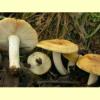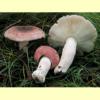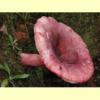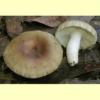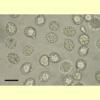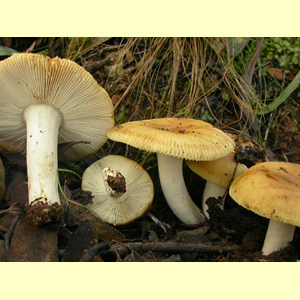
images/Russula/Russula_neerimea.jpg
Medium to large agaric, growing on the ground, with a white or cream to yellow spore print. Pileus white, pale, yellow, brown, red or pink, green, purple, grey or black, viscid or not. Lamellae adnexed, adnate, subdecurrent or with a decurrent tooth, rarely decurrent. Stipe central, rarely excentric. Partial veil remnants absent. Spores hyaline, amyloid, warty or reticulate; germ pore absent. Cheilocystidia present. Lamellar trama interwoven. Pileipellis a cutis, a trichoderm or a hymeniderm. Clamp connections absent.
The rather robust stipe with chalky flesh that readily crumbles is a good field character.
Russula is most similar to
Lactarius, which can be distinguished by the presence of latex when the lamellae or flesh is cut, and which always has lamellulae, and generally lacks sphaerocytes in the lamellar trama. Species of the small group allied to
Lactarius clarkeae (including
Russula flocktoniae) have a rich orange pileus and can lack latex, but they have sphaerocytes in the lamellar trama. Microscopically, the spores with amyloid ornamentation are distinctive. Other pale-spored agaric genera that can have robust fruit-bodies lacking an annulus include
Laccaria (spores spinose, not amyloid),
Porpoloma (spores smooth, amyloid) and
Tricholoma (spores smooth, not amyloid).
Russula Pers., Observ. Mycol. 1: 100 (1796).
About 20 agaricoid species. In native forests:
Russula aff.
adusta,
R. aff.
albonigra,
R. aff.
cyanoxantha,
R. aff.
foetens,
R. cheelii,
R. clelandii,
R. compacta,
R. erumpens,
R. ingwa,
R. iterika,
R. kalimna,
R. lenkunya,
R. marangania,
R. neerimea,
R. persanguinea,
R. purpureoflava,
R. aff.
rosacea,
R. viridis and
R. wollumbina. Under exotic trees:
R. integra (=
R. polychroma) (under pine) and
R. sororia (under oak).
There are at least as many sequestrate (truffle-like) Australian species, often formerly placed in the genus Macowanites.
W.A., S.A., Qld, N.S.W., Vic. and Tas. (and probably also N.T.).
In native forests, and also in parks, gardens and plantations with exotic oak and pine.
On the ground.
Ectomycorrhizal.
Bougher, N.L. (2009a),
Fungi of the Perth region and beyond: a self-managed field book, Western Australian Naturalists' Club (Inc.), Perth. [
Description and
Illustration of
R. erumpens and
R. persanguinea]
Bougher, N.L. & Syme, K. (1998), Fungi of Southern Australia. University of Western Australia Press, Nedlands. [Description, Illustration and Microcharacters of R. adusta, R. aff. albonigra, R. clelandii, R. aff. cyanoxantha, R. erumpens, R. neerimea and R. persanguinea]
Fuhrer, B. (2005), A Field Guide to Australian Fungi. Bloomings Books, Hawthorn. [Description and Illustration of R. kalimna, R. lenkunya, R. persanguinea, R. purpureoflava and R. aff. rosacea]
Fuhrer, B. & Robinson, R. (1992), Rainforest Fungi of Tasmania and South-east Australia. CSIRO Press, East Melbourne. [Illustration of two unnamed Russula sp.]
Grgurinovic, C.A. (1997a), Larger Fungi of South Australia. The Botanic Gardens of Adelaide and State Herbarium and The Flora and Fauna of South Australia Handbooks Committee, Adelaide. [Description and Microcharacters of R. cheelii, R. erumpens, R. ingwa, R. iterika, R. kalimna, R. lenkunya, R. marangania, R. neerimea, R. persanguinea, R. purpureoflava, R. viridis and R. wollumbina, and Illustration of R. persanguinea and R. purpureoflava, also Key to South Australian species]
Hongo, T. & Mills, A.K. (1988), Five noteworthy larger fungi new to Tasmania, Australia, Trans. Mycol. Soc. Japan 29: 351–357. [Description and Microcharacters of R. compacta]
Kränzlin, F. (ed.) (2005), Fungi of Switzerland. Volume 6. Russulaceae. Verlag Mykologia, Luzern. [Illustration, Description and Microcharacters of R. integra from Europe]
McCann, I.R. (2003), Australian Fungi Illustrated. Macdown Productions, Vermont. [Illustration of R. clelandii, R. persanguinea, R. purpureoflava, R. viridis, and an unnamed species]
Miller, O.K., Jr & Hilton, R.N. (1987), New and interesting agarics from Western Australia, Sydowia 39: 126–137. [B&W Illustration, Description and Microcharacters of R. clelandii]
Young, A.M. (2005b), A Field Guide to the Fungi of Australia. University of New South Wales Press, Sydney. [Description and B&W Illustration of R. erumpens, R. aff. foetens, R. lenkunya and R. persanguinea]

